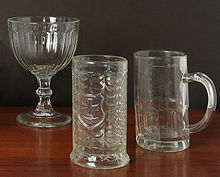Pressed glass

Pressed glass (or pattern glass)[1] is a form of glass made by pressing molten glass into a mold using a plunger.[2] Although hand pressed glass has existed for over 1,000 years, the use of a machine for pressing was first patented by Pittsburgh glass man John P. Bakewell in 1825 to make knobs for furniture.
The technique was developed in the United States from the 1820s and in Europe, particularly France, Bohemia, and Sweden from the 1830s. By the mid-19th century, most inexpensive mass-produced glassware was pressed (1850–1910).[1] One type of pressed glass is carnival glass.[3] Painted pressed glass produced in the early 20th century is often called goofus glass.[citation needed] The method is also used to make beads.[4]
See also[edit]
References[edit]
- ^ a b [1] "pressed glass". www.britannica.com. Encyclopaedia Britannica Inc. July 20, 1998. Retrieved March 3, 2022.
pressed glass, glassware produced by mechanically pressing molten glass into a plain or engraved mold by means of a plunger
- ^ Loomis, Frank Farmer (2005-09-10). Antiques 101: A Crash Course in Everything Antique. Krause Publications. ISBN 0896891585.
- ^ Cleland, Nancy N. (1993). The Archaic, Woodland, and Historic Period Occupations of the Liberty Bridge Locale, Bay City, Michigan: Submitted to City of Bay City, Michigan Department of Transportation, Michigan Department of State, Federal Highway Administration, U.S. Department of Transportation. Michigan Department of Transportation. ISBN 9780962367021.
- ^ Atkins, Robin (December 2012). The Complete Photo Guide to Beading. Creative Publishing international. ISBN 9781589237186.
